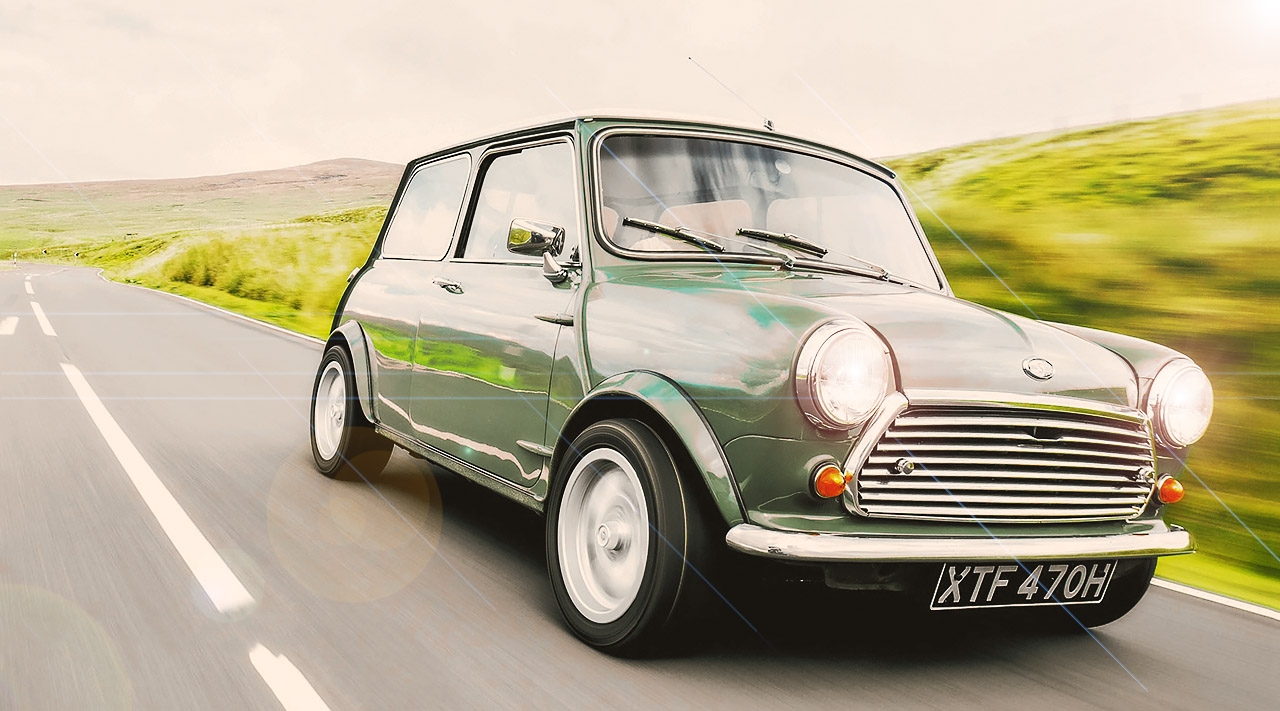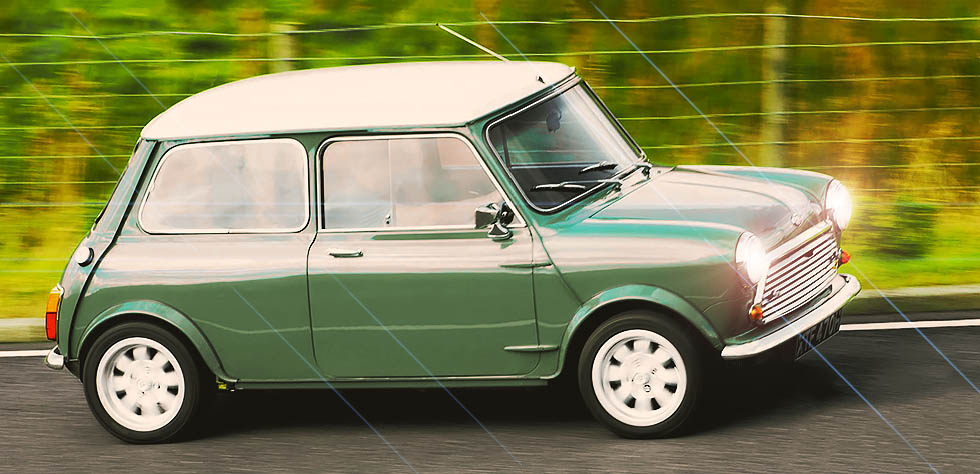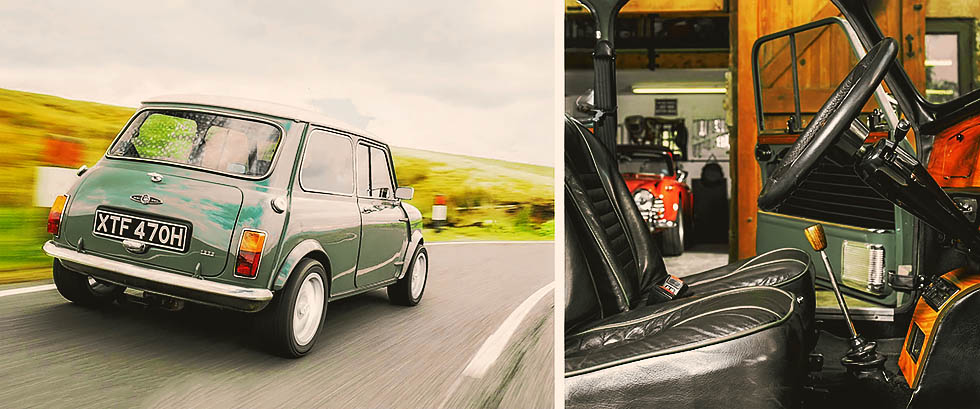
The List BL aficionado Kirk Harrison has longed to drive a Mini Cooper S ever since a teenage close encounter with his girlfriend’s 850. A Pennine blast in a MkII should do nicely, then. ‘It feels like a go-kart on steroids’. Kirk Harrison has fond memories of experiences in his first girlfriend’s Mini. We put him in a Cooper S to see if it recaptures the old magic. Words Ross Alkureishi. Photography Simon Thompson.
KIRK HARRISON
Kirk’s father worked at Browns Lane so it’s no surprise that – save for a Renault Avantime – Kirk’s car history is a comprehensive who’s who of British Leyland models, something that’s clearly reflected in his all-Britpack Wishlist.
HIS WISHLIST
DeLorean DMC-12
Aston Martin Lagonda
Lotus Esprit S1
Jaguar XJS 5.3
Jaguar E-type Series 3
Ford Escort Mexico MkI
Ford Escort RS2000 MkII
MGC Roadster
Mini Cooper S
The build-up to this particular dream drive has bubbled away rather longer than normal. Usually the chosen reader meets up with the writer and photographer just before the shoot but London-based Kirk Harrison has taken us up on our offer of escaping the Big Smoke in search of driving nirvana. Cue a shared train journey to Cumbria during which he explains his reasons for choosing a Mini Cooper S.
‘Everyone had Minis growing up but the Cooper S was the icing on the cake,’ he says. ‘I loved the idea of hotting up such a basic car – I grew up with The Italian Job and the Minis were always the true hero cars to me rather than the Jaguar E-type, Miura or DB4.

‘My first girlfriend had a Mini 850 in a horrible orange colour. I remember going to parties in it when I was 17 but never drove it. Still, we’ve all had memorable experiences in a Mini!’
Early next morning we reach our destination – Lakes and Dales Classic Car Hire in the foothills of the Pennines near Penrith. Rob and Kerry Hammond’s fleet contains all manner of British metal including a Triumph TR4A, Austin-Healey 3000 and a couple of Morgans, as well as our Mini Cooper S.
It’s far from standard – this Snowberry White over Almond Green MkII kicks out close to 100bhp thanks to a host of engine modifications and has a Jack Knight straight cut gearbox, wider wheels and tyres and stiffer suspension. ‘I don’t mind a car upgraded for driveability,’ says Kirk. ‘It’s a bit more aggressive looking than standard and you just know you’re going to have a lot of fun before you even get into it.’
Once on board Kirk is already impressed. ‘The driving position is great – I don’t feel like I’m sitting on the floor. The steering wheel is close too so I don’t have to reach for it.’ He admires the Wood& Pickett dashboard and fiddles with the sliding window. ‘It’s little details like this that really take me back,’ he grins.
He pumps the accelerator a couple of times, twists the ignition key and the cabin is immediately flooded with glorious induction noise. We set off on a series of narrow country lanes and join the twisting A686 towards Alston. ‘The steering felt quite heavy when I was manoeuvring it,’ Kirk says, ‘but it’s really lightened up now.’ With the speed rising he’s clearly tapped into the Mini’s immediacy. ‘It’s quite bouncy,’ he says as we skip along one particularly rough stretch like a pebble skimmed across a pond, ‘but I really feel in touch with the road.’
Armed with Kerry’s route map, we begin the climb from the village of Melmerby up to Hartside summit and the first few twisty bits elicit howls of delight from the driver. ‘I just love the chuckability of this thing,’ he enthuses. ‘The handling is just unbelievable. I’ve driven bog-standard Minis before but this has so much more poke and grip. It feels like a go-kart on steroids.
‘And this straight-cut gearbox is a delight,’ he adds, flicking the lever from third to second by way of demonstration and nailing the throttle. ‘It really suits the car.’
The higher we climb, the more challenging the road becomes, long sweeping corners tightening suddenly into hairpins as the Cumbrian countryside falls away into the distance. ‘The turning circle is tiny,’ says Kirk, sawing away at the wheel. ‘I’m spinning it on a sixpence.
‘You have to hang on to it a little bit but it’s great – I can feel every single bump in the road. Modern cars might have better performance but they’re so refined that you just don’t get this sort of connection with the road.’
Our breathless sprint to the 1903ft summit completed, we turn into the Hartside Café’s car park. ‘Cuppa?’ offers Kirk. ‘No chance,’ I reply, taking the keys from him and jumping out of the car. It’s a bit early for a driver swap but I want to experience first hand what I’ve just witnessed from the passenger seat. My long legs make the driving position feel a little compromised so I adopt an awkward spatchcock chicken pose behind the steering wheel before angling the car back on to the road.

The engine sings crisply, giving satisfying barks with every prod of the accelerator pedal. Acceleration is vivid, the gearchanges lightning-quick and I learn that smooth throttle application eliminates any torque-steer. Most obvious of all though is the sheer level of communication fizzing through the steering wheel – only a Lotus Elan comes close to such immediacy.
Road-holding is sensational. I’d add stickability to Kirk’s earlier improvised chuckability adjective because the Cooper S follows every single one of my inputs faithfully. I brake late and tuck its flat snout tightly into the corner before feeding in the power. I was a little worried that Rob’s enhancements might have contaminated the original’s purity but if anything the opposite is true. You can drive it hard yet remain well within safe limits. Try doing that in a supercar.
After our second ascent and a quick lunch stop, Kirk takes the wheel again for the drop down to Alston, England’s highest market town, before we head south-east. Long stretches of the A686 we tackled earlier have clearly been recently resurfaced, so as we return to poorer surfaces the Hydrolastic suspension transforms us into a pair of tightly strapped-in nodding dogs.
Time is pressing on so we decide to cut across to the A66 and stretch the Mini’s legs on the drive back, only to find it blocked by an accident. This puts a different spin on things – we’re due on the 5.03pm train back to Euston and there’s no obvious direct route back to Blencarn. There’s nothing for it – it’ll have to be a crosscountry suck-it-and-see.
Kirk doesn’t hesitate – he’s instantly right on it. The lanes are tight but deserted so progress is rapid on the long secluded straights and now-familiar Cumbrian twists and turns. ‘Paddy Hopkirk’s rally exploits were a bit before my time,’ he shouts over the howling A-series engine, ‘but I can see now why he was so successful in the Mini.’ He’s absolutely spot on. The Mini just devours the miles irrespective of the gradient, camber or corner you throw at it – it’s a real terrier of a car.
Suddenly, the road rises unexpectedly and too late I spot a hump half-hidden in the road ahead. We’re nearly airborne a split-second later but the S simply takes it in its stride.
This prompts big smiles all round – of relief more than anything else – and we arrive back at Lakes and Dales 25 minutes later. ‘I’m going to feel it in my backside tomorrow,’ Kirk says as he climbs out of the Mini and stretches. For me it’ll be my back suffering from the original seats’ limited support but it seems a small price to pay for such a scintillating day’s driving.
Rob observes the symmetrical mud splashes down each of the Mini’s flank and looks at me accusingly. ‘Sorry about that,’ I offer. Clearly he’s already developed a bond with the car.
So have I. Today has been one of those rare days in which we’ve driven the perfect car on perfect roads, but would the Mini Cooper S make it into Kirk’s dream garage? ‘Definitely,’ he says.
‘It’s still a great city car just like the Issignonis-designed original but one that you can take on a hard blast on winding A- and B-roads.
‘Compared to my other cars – two autos and a much bigger and heavier Triumph Stag – you really do have to drive this,’ he says. ‘And for me growing up in the Seventies, this was always more of a poster car than the Lamborghini Countach ever was. Its greatest appeal was always in its attainability, something Aston Martins, Lamborghinis and Ferraris never had.’ Even today, a sorted Cooper S remains relatively affordable – especially when you consider the performance, low running costs and first-class parts availability.
Combine this with the Cooper’s inherent simplicity – one of the reasons they continue to make such great rally cars – and it’s no surprise that Kirk’s fallen for this proven winner.
‘You can get the current Mini Cooper S as a diesel estate,’ he grumbles. ‘I mean, seriously? It’s demeaning to the badge. ‘This on the other hand,’ he says with a wink, ‘is the most fun I’ve had in a Mini in 25 years!’
Thanks to: Lakes and Dales Classic Car Hire (lakesanddales.co.uk, 01768 879091)
1969 MINI COOPER S MKII
Engine 1275cc, four-cylinder, ohv, twin 1¼in SU carburettors
Power and torque 76bhp @ 5800rpm; 79lb ft @ 3000rpm
Transmission Four-speed manual, front-wheel drive
Brakes Front: discs. Rear: drums
Suspension Front: independent with unequal length arms, interconnected Hydrolastic displacers. Rear: independent with trailing arms, interconnected Hydrolastic displacers
Steering Rack and pinion
Weight 1400lb (635kg)
Performance
Top speed: 98mph; 0-60mph: 10.9sec
Fuel consumption 29.9mpg
Cost new £849
Current value £25,000
BMC’S ILL – FATED 4X4
The Twini had a short and unsuccessful life – here it is on the Targa Florio in 1963.
THE TWINI-COOPER
The Twini’s two engines and four-wheel drive promised rallying dominance, but a near-fatal 100mph smash killed the project of.
Fulham race engineer Paul Emery is frequently credited as being the first to have designed a twin-engined Mini. His abandoned concept later inspired Alec Issigonis’ 1962 four-wheel-drive Mini Moke whose 948cc and 848cc engines gave a combined 1796cc and 71bhp.

John Cooper sampled the Moke’s impressive torque and traction at Longbridge and immediately set about designing a twin-engined Mini Cooper. He had both rallying and circuit racing in mind – with 100 made it could compete in GT racing, but if BMC built 1000 it could be homologated as a touring car.
His team delivered a working prototype within just six weeks. At the front was an 82bhp 1088cc engine and in the rear a 96bhp 1212cc motor driving the rear wheels. Considerable structural strengthening of the bodyshell was required together with a reinforced rear subframe. Both gearboxes had identical ratios and were linked via a sliding rod so changes happened in unison.
A combined 178bhp turned the standard Cooper S into a potent road rocket. Racing driver John Whitmore tested it at Brands Hatch and praised its neutral handling with both engines in synch but reported a distinct deterioration in handling if one of them started to play up. Its first outing at the Goodwood Members’ Day race ended in ignominy when it failed to start after losing a fan pulley in practice.
BMC developed a pair of twin-engined Mini saloons of its own around the same time. The first was powered by a pair of 55bhp Mini Cooper engines and the second, developed by Downton Engineering, used two tuned Riley Elf engines giving a combined 154bhp. The Downton car competed in the 1963 Targa Florio at the hands of John Whitmore and Le Mans winner Paul Frère, who came out of retirement especially for the event. It burst its radiator on the start line, but worse was to come when malfunctioning gearchange synchronisation caused the engines to turn at different speeds and the eventual loss of the second engine. It came fifth in the prototype class and 27th overall – two places below the standard Cooper S of Bernard Cahier and Rob Slotemaker.
Despite these setbacks BMC felt the concept had merit and looked set to finally bring four-wheel drive to both circuit racing and rallying.
This promise came to a sudden and brutal halt in May 1963 when John Cooper suffered an enormous accident in the car on the A3 Kingston bypass. With the steering rack removed from the rear subframe, the steering links had been used as another suspension arm. Cooper believed that a seized balljoint caused the arm to break and the wheel to turn sharply right, resulting in a catastrophic 100mph end-over-end smash into a wall that destroyed the car and left Cooper fighting for his life.
The resultant negative publicity prompted BMC to kill off the Twini project, leaving the revolutionary Audi quattro to bring four-wheel drive to the world of rallying some 17 years later.
‘The Twini’s promise came to a brutal halt when John Cooper had an enormous accident in it’
Reader Kirk loved the Cooper’s cornering feel and chuckability.
Straight-cut gearbox wrings the absolute maximum out of the Cooper’s engine.
‘We’re nearly airborne but the S simply takes it in its stride’
THE EVOLUTION
1959 MKI
A transverse engine, sump-mounted gearbox and front-wheel drive ensured a rapturous welcome from the motoring world for Alec Issigonis’ tiny tour de force. The general public took a while longer to catch on, but there was no stopping it thereafter. 848cc A-Series power meant a perky and entertaining drive, while still being cheap to buy. Initially sold as the Austin Seven and Morris Mini- Minor, the famous Mini moniker stuck from 1961 onwards with Hydrolastic suspension arriving in 1964. A true social leveller, beloved of millionaire rock stars and families alike.
1961 COOPER 997/998
John Cooper’s ‘hot’ Mini added extra power, improved disc braking and a remote gearchange to the original’s phenomenal handling. Initially with a 55bhp long stroke/narrow bore 997cc twin carburettor engine and later a short-stroke 998cc from the Riley Elf with identical power. Longer gear ratios gave a top speed of 87mph and duotone paint lent it a unique character perfect for its immediately successful deployment in competition. MkII version followed from 1967, with production finally ending two years later.
1963 COOPER 1071S/ 1964 COOPER 970S
If the Cooper was hot then the S was positively scalding. Joint Downton Engineering/Morris Engines-developed 1071cc engine produced 70bhp thanks to a fresh camshaft, revised valves and new carburettors. Two gearboxes and final drives offered, with bigger front discs and ventilated wheels. Won the 1964 Monte Carlo Rally outright in the hands of Paddy Hopkirk and Henry Liddon. Production ended after a year. Special order only 970S homologation special used a shortstroke 65bhp engine.
1964 COOPER 1275S
Widely regarded as the best of the breed with considerable kudos from three Monte Carlo titles and a memorable starring role in the 1969 crime caper The Italian Job. Unlike other Minis, it was still available in Austin or Morris flavours. Good for 0-60mph in just 11 seconds and a top speed just shy of 100mph thanks to its long-stroke power plant. Oil cooler and twin fuel tanks arrived in 1966, before MkII in 1967 and MkIII – with concealed door hinges and wind-up windows – two years later. Production ended in 1971 after a long and illustrious career.
A-series looks standard but a host of modifications have boosted power to nearly 100bhp.
Wider tyres and stifer suspension ramp up reader Kirk Harrison’s Cooper S experience.
‘We begin the climb to Hartside and the first few twisty bits elicit howls of delight from the driver’





